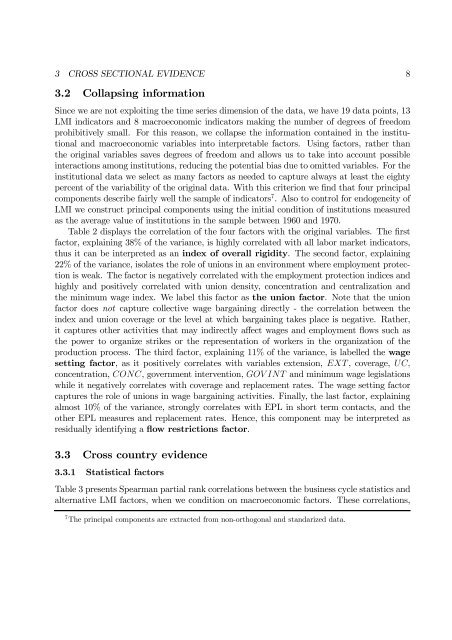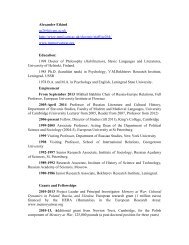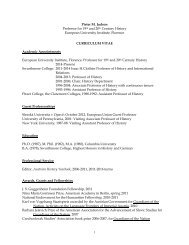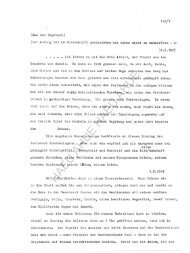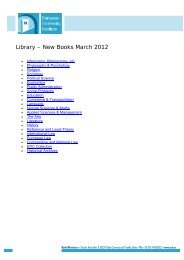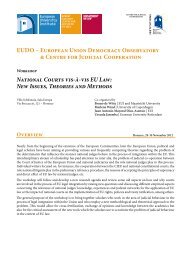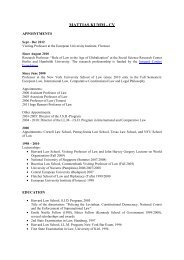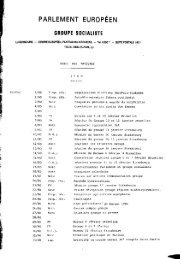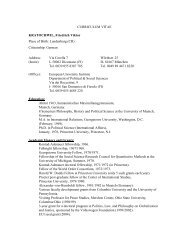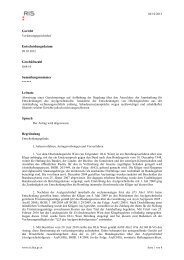Do labor market institutions matter for business cycles?∗ - European ...
Do labor market institutions matter for business cycles?∗ - European ...
Do labor market institutions matter for business cycles?∗ - European ...
You also want an ePaper? Increase the reach of your titles
YUMPU automatically turns print PDFs into web optimized ePapers that Google loves.
3 CROSS SECTIONAL EVIDENCE 8<br />
3.2 Collapsing in<strong>for</strong>mation<br />
Since we are not exploiting the time series dimension of the data, we have 19 data points, 13<br />
LMI indicators and 8 macroeconomic indicators making the number of degrees of freedom<br />
prohibitively small. For this reason, we collapse the in<strong>for</strong>mation contained in the institutional<br />
and macroeconomic variables into interpretable factors. Using factors, rather than<br />
the original variables saves degrees of freedom and allows us to take into account possible<br />
interactions among <strong>institutions</strong>, reducing the potential bias due to omitted variables. For the<br />
institutional data we select as many factors as needed to capture always at least the eighty<br />
percent of the variability of the original data. With this criterion we find that four principal<br />
components describe fairly well the sample of indicators 7 . Also to control <strong>for</strong> endogeneity of<br />
LMI we construct principal components using the initial condition of <strong>institutions</strong> measured<br />
as the average value of <strong>institutions</strong> in the sample between 1960 and 1970.<br />
Table 2 displays the correlation of the four factors with the original variables. The first<br />
factor, explaining 38% of the variance, is highly correlated with all <strong>labor</strong> <strong>market</strong> indicators,<br />
thus it can be interpreted as an index of overall rigidity. The second factor, explaining<br />
22% of the variance, isolates the role of unions in an environment where employment protection<br />
is weak. The factor is negatively correlated with the employment protection indices and<br />
highly and positively correlated with union density, concentration and centralization and<br />
the minimum wage index. We label this factor as the union factor. Note that the union<br />
factor does not capture collective wage bargaining directly - the correlation between the<br />
index and union coverage or the level at which bargaining takes place is negative. Rather,<br />
it captures other activities that may indirectly affect wages and employment flows such as<br />
the power to organize strikes or the representation of workers in the organization of the<br />
production process. The third factor, explaining 11% of the variance, is labelled the wage<br />
setting factor, as it positively correlates with variables extension, EXT , coverage, UC,<br />
concentration, CONC, government intervention, GOV INT and minimum wage legislations<br />
while it negatively correlates with coverage and replacement rates. The wage setting factor<br />
captures the role of unions in wage bargaining activities. Finally, the last factor, explaining<br />
almost 10% of the variance, strongly correlates with EPL in short term contacts, and the<br />
other EPL measures and replacement rates. Hence, this component may be interpreted as<br />
residually identifying a flow restrictions factor.<br />
3.3 Cross country evidence<br />
3.3.1 Statistical factors<br />
Table 3 presents Spearman partial rank correlations between the <strong>business</strong> cycle statistics and<br />
alternative LMI factors, when we condition on macroeconomic factors. These correlations,<br />
7 The principal components are extracted from non-orthogonal and standarized data.


